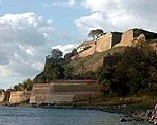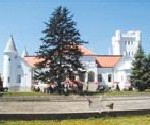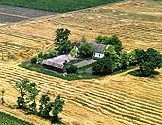|
In the north of
Serbia and in the southeast of the vast Pannonian Plain, bordered by the rivers
Danube and Sava and by the state borders with Hungary and Romania, lies the
Autonomous Province of Vojvodina. For centuries, the region of Vojvodina has
been the point of great migrations of the Serbs from the south. Two great
empires, the Austrian and the Ottoman, clashed here in the 17th and 18th
centuries, so did the two cultures: the East and the West also touched it,
leaving the traces which are still visible in the buildings from that period. By
the end of the 18th century the recovery of the Serbian culture was taking place
and the foundations of the modern Serbian society were laid. The Serbian culture
was renewed here under European influence, and the spiritual and political
center of the Serbs in the Hapsburg Empire was the small town of Karlovci. First
grammar schools were founded, then theatres, libraries, newspapers, cultural
institutions... here, in the north.
Because of its extraordinary soil and climate, this agricultural and mainly flat
region has been not only the breadbasket of the country but also the most
developed area of Serbia in general. Even today and despite the wars in former
Yugoslavia, this peaceful region has retained its centuries-long and
recognizable points: its multinational, multicultural and multi-confessional
features.
These are qualities
that the people of Vojvodina can be proud of.
|
Tour #
14
|
 Vojvodina Tour
Vojvodina Tour
|
|
2 days/1 night, by car or minivan |
Highlights:
Sremski Karlovci
is a town of extraordinary
cultural heritage. It was the spiritual and cultural centre of the
Serbs in the 18th and 19th centuries and the meeting place of almost all Serbian national-church assemblies. There are several
monuments
of architectural and artistic interest, such as a Baroque-style fountain from
1790, the Karlovci High School from the end of the 19th century with decorative
elements reminiscent of mediaeval Serbian buildings, the Patriarch's Palace -
once the most imposing building in the whole region, the Cathedral Church from
the mid-18th century, and many others.
Petrovaradin Fortress
('Gibraltar on the Danube')
is a fascinating artillery
structure located on a small hill on the right bank of the Danube opposite
modern Novi Sad. The Ottoman Turks captured it in 1526 and held it for 130 years when it passed into the hands of the Austrians. This marked the
beginning of several successive reconstructions and enlargements. The last one
was carried out in the mid-18th century, when the
fortress got its final appearance. Its massive walls built to resist
heavy artillery encompass the lower garrison town and extend to the bank of the
river. Subterranean galleries run beneath the walls, and there is a number of
buildings within the fortress, which were once used as barracks and now house a
museum, the archives and art studios.
Fantast Castle
is the best
preserved and most renowned castle in this region.
A magnificent view from its
balconies spreads across the whole complex, a small lake nearby and the Pannonian landscape
all around. The
architect is unknown, but he was apparently under the influence of European, and
particularly French castles. There are traces of various styles, such as Romanticism, the Gothic
culture, Renaissance. The castle's original owner, Bogdan Dundjerski was a great
horse-lover who managed to establish one of the biggest horse-farms in this part
of Europe with almost 1,400 horses. The castle was named after the
famous horse called Fantast.
Kovacica
is a town internationally
known for its self-taught artists of Naïve Art, such as Zuzana Halupova, Martin
Jonaš, Jan Sokol, Jan and Ondrej Vanjaski and others. Their art is a genuine,
spontaneous and instinctive realism, with a strong influence of directness,
honesty, imagination and fiction. The Gallery of Naïve Painters in
Kovacica was founded in 1955 with an idea to present the wide artistic
potential of the people from this picturesque town. Apart from the main gallery,
there are a few other smaller shops in the same complex selling naïve paintings.
Day 1
BELGRADE- KRUSEDOL-SREMSKI
KARLOVCI-PETROVARADIN FORTRESS-NOVI SAD-PALIC LAKE
Departure at 8.30 a.m. Upon arrival in
the region of Fruska
Gora, we will visit Krusedol
monastery (founded in the 16th century) known for its attractive location,
historical importance and a variety of decorative frescos in its church. Next,
a stop in the romantic town of Sremski Karlovci. You will enjoy a panoramic guided walk
of the town center, which features the Baroque 'Four Lions' fountain on the main square (1790),
a 19th century High school, the Patriarch's Palace and the
mid-18th century Cathedral
church with its fine Renaissance facade and two Baroque belfries. En route to Novi
Sad we visit the famous fortress of Petrovaradin,
after Verdun the second largest structure of its kind preserved in Europe.
Later, you will take a panoramic tour of Novi Sad, the
capital of Vojvodina.
Leave for Palic Lake, accommodation at the lakeside hotel. A brief guided walk
around the area. Dinner, overnight.
Day 2
PALIC LAKE-SUBOTICA-FANTAST CASTLE-KOVACICA-BELGRADE
After breakfast you have some
free time to
enjoy the beauties of this unique natural setting. Then we visit the town of Subotica, situated near the border with
Hungary. You will enjoy a guided walk of the town center, which features
the Town Hall, built in Art
Nouveau style in the first decade of the 20th century, the Synagogue, one of the most valuable middle-European creations of this kind of sacral architecture, the
neo-classical façade of the National Theatre - in Hungarian Népszínház with
its colossal Corinthian pillars, and
more. Leave for the Fantast Castle,
an extraordinary example of twentieth century historicist building,
where you'll tour this
attractive architectural complex recently transformed into
a hotel. Optional lunch. On the
way back to Belgrade, we stop at Kovacica and visit the famous
Gallery of Naïve Painters (including some time to shop for
souvenirs). Return to Belgrade in
the evening.
Dinner on first day.
Breakfast on second day.
Accommodation 3*/4*.
|
|


